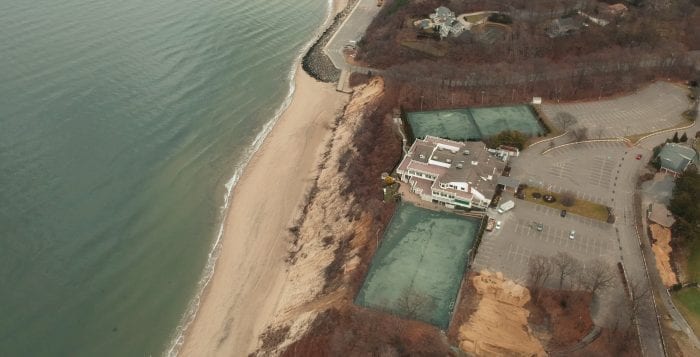By Sabrina Artusa
With further recession of the East Beach bluff threatening the safety and structural integrity of the Port Jefferson Country Club, tennis and pickleball courts and golf course, the Village of Port Jefferson held a town hall meeting May 28 at the Waterview catering hall to discuss how to proceed with the bluff revitalization plan initiated in 2021. This plan was interrupted by fierce storms that damaged the barrier wall the village spent two years and approximately $6 million building.
While portions of the wall held strong against runoff and winds, the damage has made some residents unsure if continuing with Phase II is the most effective solution. The Federal Emergency Management Agency is funding 75% of Phase II, but the specifics of the grant agreement have not been finalized.
Country club
Some residents question why money should be spent protecting a commercial business and argue for the demolition of the village-owned country club and rebuilding further from the cliff.
“There are a lot of people in this town who are hurting. Inflation is hurting middle American families … we talk about putting millions of tax dollars into this beautiful club, but for what?” one resident asked.
“It’s not just an engineering issue. It’s a cost-benefit analysis for the entire community, and a referendum requires that we be included,” another person said.
The club, however, reportedly brings in over $300,000 of revenue to the village annually. Additionally, one does not have to be a member of the country club to visit.
“When you are repairing the bluff, what is it actually going to protect? It is going to protect a building that is revenue neutral at its worst and it sounds like it is a revenue positive facility,” another resident said.
Other options
Mayor Lauren Sheprow said that the wall held strong for the most part and that engineers and environmental scientists are being consulted on the most responsible course of action going forward.
Nick Thatos, co-founder of the Long Island-based Coastal Technologies, said that planting native species is key to preventing further erosion. He noted that North Shore native plants evolved “to stabilize” and “colonize this niche environment,” citing the complex root systems and cement-like excretions that can keep sand in place.
“Nature is incredible. We cannot engineer anything near what nature can accomplish,” he said.
Some said that the angle of the bluff needs to be corrected to prevent recession, while others said that retreating is the most dependable option.
“The only way to fortify the top is to retreat,” said a woman who has lived in Port Jefferson for over 30 years. “The golf and tennis are separate. Another building can be built.”
Sheprow is asking for volunteers for the village’s Citizens Commission on Erosion. “We want input, we don’t want to do it in a vacuum,” she said.








